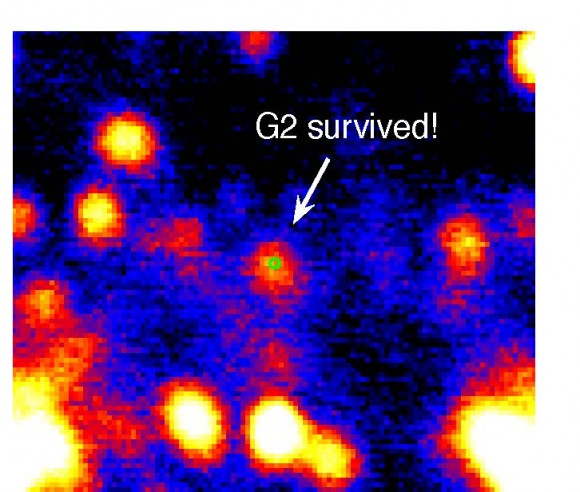
The 4-million-solar-mass black hole at the center of our Milky Way – Sagittarius A* (or Sgr A*, pronounced Sajj A-star) – is usually pretty quiet. Over the past few years, astronomers have watched a mysterious, dusty object that they call G2 sweep near the hole. They hoped for fireworks when G2 fell into the hole, but, as it passed closest, there was no big effect. Now it appears that G2 survived mostly intact. But perhaps now they are seeing an effect. Scientists using combined data from three orbiting X-ray space telescopes report a recent tenfold increase in the rate of X-ray flares from the Milky Way’s black hole within the past year. They’re trying to determine whether these flares are normal behavior – unnoticed due to limited monitoring – or whether G2’s passage triggered the flares.
The three space telescopes are NASA’s Chandra X-ray Observatory, ESA’s XMM-Newton, and the Swift satellite. By combining data from these three, astronomers traced the activity of the Milky Way’s supermassive black hole over a 15-year period.
The study reveals that, until recently, the Milky Way’s black hole has been producing one bright X-ray flare about every 10 days. Within the past year, the rate has increased to about one every day. This increase happened soon after the closest approach to Sgr A* by G2.


It’s logical to assume that G2’s close passage to the black hole might cause an increase in X-ray flares. X-rays are known to be produced by hot gas flowing toward a black hole.
What is G2, and did it bump up the rate of X-ray flares in our Milky Way’s central black hole?
Originally, astronomers thought G2 was an extended cloud of gas and dust. After it passed closest to Sgr A*, though, in late 2013 and early 2014, its appearance didn’t change much, apart from being slightly stretched by the gravity of the black hole. This led to new theories that G2 was not simply a gas cloud, but instead a star swathed in an extended dusty cocoon.
So astronomers aren’t sure what G2 is. They also aren’t sure if the recent increase in X-rays comes from G2’s passage near the hole.
Gabriele Ponti of the Max Planck Institute for Extraterrestrial Physics in Germany said in a September 23, 2015 statement from Chandra:
A year or so ago, we thought it had absolutely no effect on Sgr A*, but our new data raise the possibility that that might not be the case.
That’s because astronomers see other black holes with similar behavior. They say it’s possible that what they call increased chatter from Sgr A* might be a common trait among supermassive black holes. It might be unrelated to G2. In that case, the increase in X-ray flares could, for example, represent a change in the strength of stellar winds from nearby massive stars that are feeding the black hole.
They do say, though, that the timing of G2’s passage with the surge in X-rays from Sgr A* is intriguing.
Barbara De Marco, also of Max Planck and a co-author on the new study, said:
It’s too soon to say for sure, but we will be keeping X-ray eyes on Sgr A* in the coming months.
Hopefully, new observations will tell us whether G2 is responsible for the changed behavior or if the new flaring is just part of how the black hole behaves.

Bottom line: The black hole at the heart of Milky Way – called Sagittarius A* or Sgr A* for short – has within the past year blasted out 10 times its normal rate X-ray flares. Astronomers speculate that the increase in X-rays might be due to the close passage of a mysterious, dusty object that they call G2. But they’re not sure.











